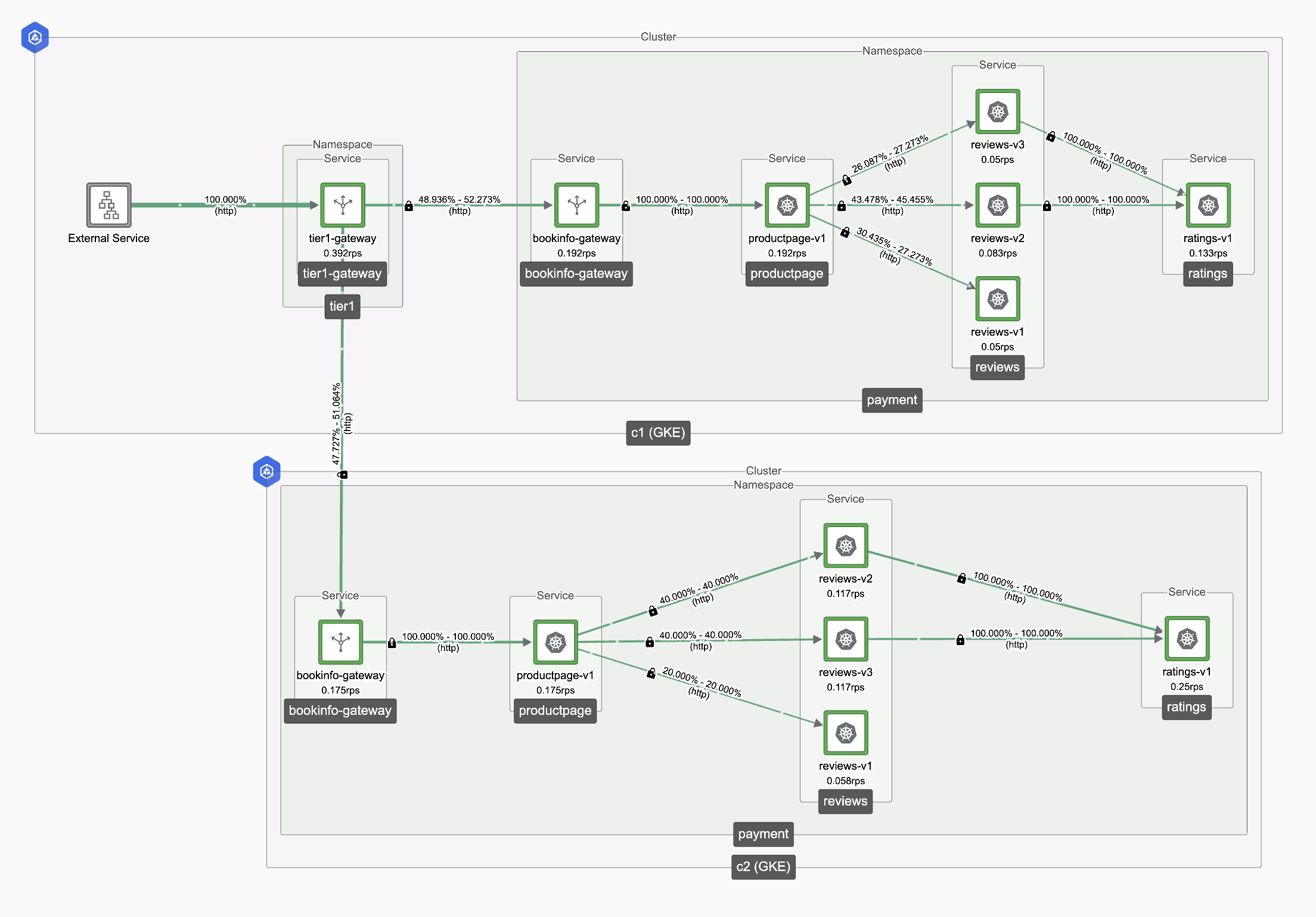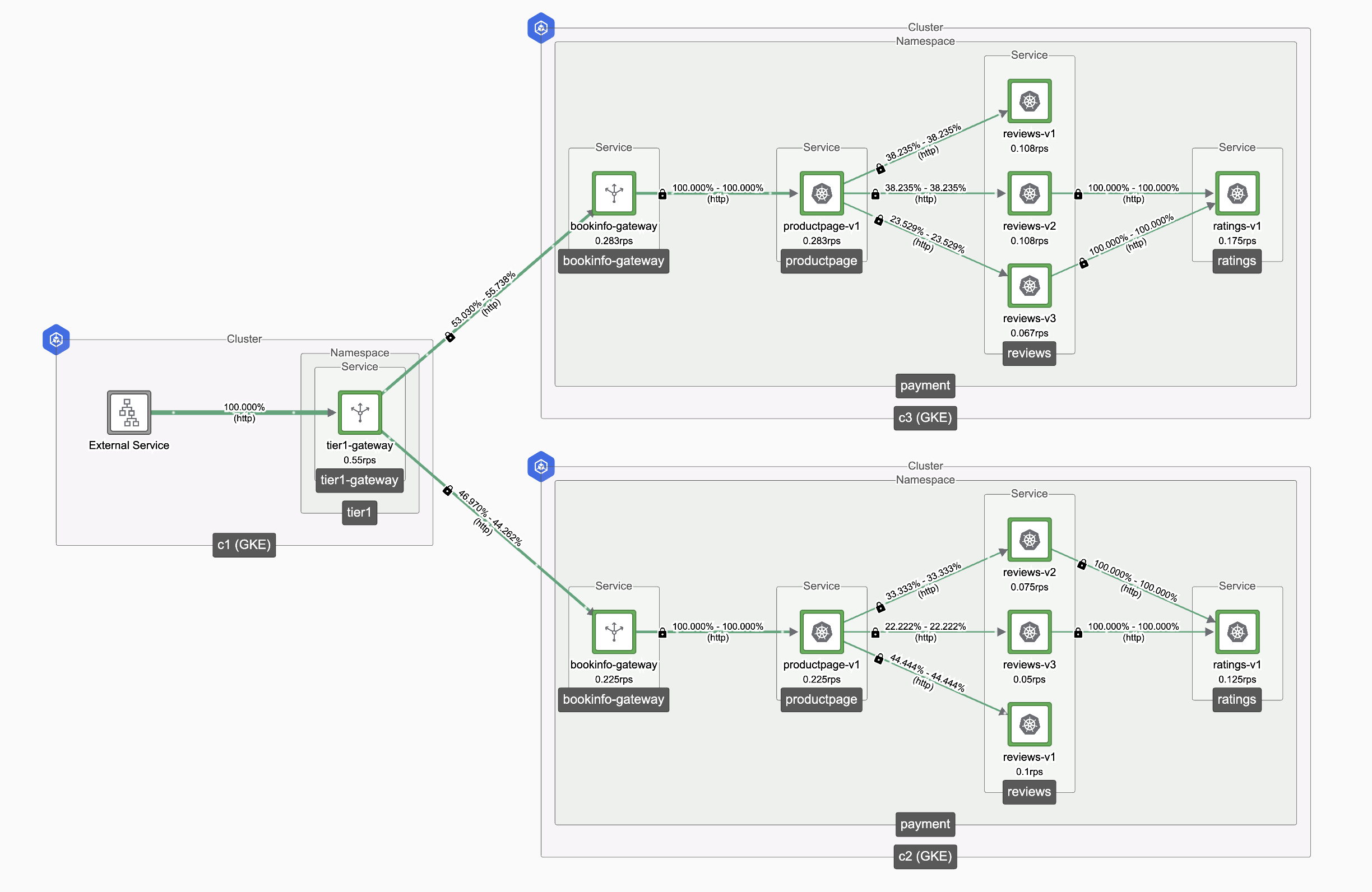Edge Gateway Failover with Multi Cluster Weighted Traffic Distribution
This document serves as an extension to Priority-Based Multi-Cluster Traffic Routing and Failover. With the latest enhancements in TSB 1.12, users can now configure a custom failoverPriority order, allowing greater flexibility in determining how fallback clusters are selected during a failover.
This document provides detailed guidance on configuring failoverSettings to enable failovers between Tier 1 and Tier 2 Gateways spanning multiple regional clusters, based on a custom failover priority order.
Use case
Organizations operating across multiple geographic regions often deploy Tier 1 and Tier 2 Gateways across multiple regional clusters and different availability zones to ensure high availability and resilience. In a failover event, the default behavior may not align with business or operational priorities, leading to inefficient routing and potential service disruptions.
With TSB 1.12, users can define a custom failover priority order, ensuring that traffic is rerouted in a controlled and predictable manner. By leveraging failoverSettings, enterprises can:
- Prioritize specific clusters based on latency, capacity, or geographic proximity.
- Ensure seamless failover transitions between
Tier 1andTier 2Gateways. - Minimize downtime and optimize performance during regional outages or network disruptions.
This document provides a step-by-step configuration guide to implementing this feature effectively.
How to Configure FailoverPriority Settings?
FailoverPriority is an ordered list of labels used for priority-based load balancing, enabling traffic failover across different endpoint groups. These labels are matched on both the client and endpoints to determine endpoint priority dynamically. A label is considered for matching only if all preceding labels match; for example, an endpoint is assigned priority P(0) if all labels match, P(1) if the first n-1 labels match, and so on.
Failover Label Convention
To simplify configuration for end users, we have established the following failover label convention:
- Key Format:
failover.tetrate.io/<domain> - Value Format: Always set to
active(constant)
Defining Failover Priority on Client Gateway
The client gateway (GW) i.e Tier1 Gateway in this example, defines the priority order for failover, ensuring traffic is routed based on the specified domains. In the example below, domain1 has a higher priority than domain2:
failover.tetrate.io/domain1: active
failover.tetrate.io/domain2: active
Example: Tier1 Gateway Configuration
The following configuration demonstrates how to configure Tier1 gateway with failoverPriority settings:
apiVersion: gateway.tsb.tetrate.io/v2
kind: Gateway
metadata:
name: tier1-gateway
namespace: tier1
annotations:
tsb.tetrate.io/organization: tetrate
tsb.tetrate.io/tenant: tier1
tsb.tetrate.io/workspace: tier1
tsb.tetrate.io/gatewayGroup: tier1-gateway-group
spec:
workloadSelector:
namespace: tier1
labels:
app: tier1-gateway
http:
- hostname: bookinfo.tetrate.io
name: bookinfo
port: 80
failoverSettings:
failoverPriority:
- failover.tetrate.io/domain1=active
- failover.tetrate.io/domain2=active
routing:
rules:
- route:
clusterDestination:
clusters:
- name: c1
weight: 50
- name: c2
weight: 50
- name: c3
weight: 0
Annotating Tier2 Gateway Services with Failover Labels
To implement failover across multiple clusters, annotate Tier-2 (T2) gateway services in each cluster with the appropriate failover labels as shown in the table below:
| Cluster | Label Configuration | Failover Priority |
|---|---|---|
| Cluster 3 | failover.tetrate.io/domain1: active, failover.tetrate.io/domain2: active | 1st (highest priority) |
| Cluster 2 | failover.tetrate.io/domain1: active | 2nd priority |
| Cluster 1 | failover.tetrate.io/domain2: active | 3rd (least priority) |
Example: Tier2 Gateway Installation
The following configuration demonstrates how to annotate the T2 gateway in Cluster 3 with failover labels:
apiVersion: install.tetrate.io/v1alpha1
kind: Gateway
metadata:
name: bookinfo-gateway
namespace: payment
spec:
type: INGRESS
kubeSpec:
service:
type: LoadBalancer
labels:
failover.tetrate.io/domain1: active
failover.tetrate.io/domain2: active
Failover Selection Process
- Cluster 3 is selected first because it contains both
domain1anddomain2, fully matching the client GW's priority order. - Cluster 2 is selected second as it contains
domain1, which is ranked higher in the client GW’s list. - Cluster 1 is the last resort since it only contains
domain2, which has a lower priority.
By following this structured failover priority mechanism, traffic failover is executed efficiently, ensuring optimal availability and performance across multiple clusters.
TSB Setup & Configuration
In this guide, you are going to -
✓ Deploy bookinfo application distributed across multiple application clusters with an IngressGateway deployed on each.
✓ Deploy Gateway resource in one of the cluster as Tier1 Gateway to distribute the traffic to multiple application clusters configured as Tier2.
✓ Configure FailoverSettings in Tier1 Gateway to achieve a custom failover priority between the configured Tier 2 clusters.
Before you get started, make sure:
✓ TSB is up and running, and GitOps has been enabled for the target cluster
✓ Familiarize yourself with TSB concepts
✓ Completed TSB usage quickstart. This document assumes you are familiar with Tenant Workspace and Config Groups.
Setup
In this setup, we have provisioned 3 clusters i.e c1 and c2 and c3 in 3 different regions.
Deploy Bookinfo application
Create the namespace payment in c1, c2 & c3 and enable istio-injection: enabled.
kubectl create namespace payment
kubectl label namespace payment istio-injection=enabled --overwrite=true
kubectl apply -f https://docs.tetrate.io/examples/flagger/bookinfo.yaml -n payment
Create TSB configurations
Create TSB configurations Tenant, Workspace, Group for bookinfo
- tctl
- k8s/gitOps
apiVersion: api.tsb.tetrate.io/v2
kind: Tenant
metadata:
name: payment
organization: tetrate
spec:
displayName: Payment
---
apiVersion: api.tsb.tetrate.io/v2
kind: Workspace
metadata:
name: payment-ws
organization: tetrate
tenant: payment
spec:
displayName: payment-ws
namespaceSelector:
names:
- 'c1/payment'
- 'c2/payment'
- 'c3/payment'
---
apiVersion: traffic.tsb.tetrate.io/v2
kind: Group
metadata:
name: payment-tg
organization: tetrate
tenant: payment
workspace: payment-ws
spec:
displayName: Payment Traffic Group
namespaceSelector:
names:
- 'c1/payment'
- 'c2/payment'
- 'c3/payment'
configMode: BRIDGED
---
apiVersion: gateway.tsb.tetrate.io/v2
kind: Group
metadata:
name: bookinfo-gg
organization: tetrate
tenant: payment
workspace: payment-ws
spec:
displayName: Bookinfo Gateway Group
namespaceSelector:
names:
- 'c1/payment'
- 'c2/payment'
- 'c3/payment'
configMode: BRIDGED
---
apiVersion: gateway.tsb.tetrate.io/v2
kind: Gateway
metadata:
name: bookinfo-ingress-gateway
organization: tetrate
tenant: payment
workspace: payment-ws
gatewayGroup: bookinfo-gg
spec:
displayName: Bookinfo Ingress
workloadSelector:
namespace: payment
labels:
app: bookinfo-gateway
http:
- hostname: bookinfo.tetrate.io
name: bookinfo-tetrate
port: 80
routing:
rules:
- route:
serviceDestination:
host: payment/productpage.payment.svc.cluster.local
port: 9080
Apply configuration using kubectl
tctl apply -f bookinfo.yaml
apiVersion: tsb.tetrate.io/v2
kind: Tenant
metadata:
name: payment
annotations:
tsb.tetrate.io/organization: tetrate
spec:
displayName: Payment
---
apiVersion: tsb.tetrate.io/v2
kind: Workspace
metadata:
name: payment-ws
annotations:
tsb.tetrate.io/organization: tetrate
tsb.tetrate.io/tenant: payment
spec:
displayName: Payment Workspace
namespaceSelector:
names:
- 'c1/payment'
- 'c2/payment'
- 'c3/payment'
---
apiVersion: traffic.tsb.tetrate.io/v2
kind: Group
metadata:
name: payment-tg
annotations:
tsb.tetrate.io/organization: tetrate
tsb.tetrate.io/tenant: payment
tsb.tetrate.io/workspace: payment-ws
spec:
displayName: Payment Traffic Group
namespaceSelector:
names:
- 'c1/payment'
- 'c2/payment'
- 'c3/payment'
configMode: BRIDGED
---
apiVersion: gateway.tsb.tetrate.io/v2
kind: Group
metadata:
name: bookinfo-gg
namespace: bookinfo
annotations:
tsb.tetrate.io/organization: tetrate
tsb.tetrate.io/tenant: payment
tsb.tetrate.io/workspace: payment-ws
spec:
displayName: Bookinfo Gateway Group
namespaceSelector:
names:
- 'c1/payment'
- 'c2/payment'
- 'c3/payment'
configMode: BRIDGED
---
apiVersion: gateway.tsb.tetrate.io/v2
kind: Gateway
metadata:
name: bookinfo-ingress-gateway
annotations:
tsb.tetrate.io/organization: tetrate
tsb.tetrate.io/tenant: payment
tsb.tetrate.io/workspace: payment-ws
tsb.tetrate.io/gatewayGroup: bookinfo-gg
spec:
displayName: Bookinfo Ingress
workloadSelector:
namespace: payment
labels:
app: bookinfo-gateway
http:
- hostname: bookinfo.tetrate.io
name: bookinfo-tetrate
port: 80
routing:
rules:
- route:
serviceDestination:
host: payment/productpage.payment.svc.cluster.local
port: 9080
Apply configuration using kubectl
kubectl apply -f bookinfo.yaml -n payment
How FailoverPriority Labels are Configured for Tier2 Gateway
To configure failover priority labels for each Tier2 Gateway proxy endpoints, you have to label the Bookinfo Tier2 Gateway services as shown below
c1 cluster
apiVersion: install.tetrate.io/v1alpha1
kind: Gateway
metadata:
name: bookinfo-gateway
namespace: payment
spec:
type: INGRESS
kubeSpec:
service:
type: LoadBalancer
labels:
failover.tetrate.io/domain2: active
c2 cluster
apiVersion: install.tetrate.io/v1alpha1
kind: Gateway
metadata:
name: bookinfo-gateway
namespace: payment
spec:
type: INGRESS
kubeSpec:
service:
type: LoadBalancer
labels:
failover.tetrate.io/domain1: active
c3 cluster
apiVersion: install.tetrate.io/v1alpha1
kind: Gateway
metadata:
name: bookinfo-gateway
namespace: payment
spec:
type: INGRESS
kubeSpec:
service:
type: LoadBalancer
labels:
failover.tetrate.io/domain1: active
failover.tetrate.io/domain2: active
Apply configuration using kubectl in each clusters
kubectl apply -f gateway-install.yaml -n payment
How FailoverPriority Settings are Configured for Tier1 Gateway
Create Gateway as Tier1 Gateway to distribute the traffic to Tier2 Gateways deployed in c1, c2 & c3
- tctl
- k8s/gitOps
apiVersion: api.tsb.tetrate.io/v2
kind: Tenant
metadata:
name: tier1
organization: tetrate
spec:
displayName: Tier1
---
apiVersion: api.tsb.tetrate.io/v2
kind: Workspace
metadata:
name: tier1-ws
organization: tetrate
tenant: tier1
spec:
displayName: Tier1
namespaceSelector:
names:
- 'c3/tier1'
---
apiVersion: gateway.tsb.tetrate.io/v2
kind: Group
metadata:
name: tier1-gg
organization: tetrate
tenant: tier1
workspace: tier1-ws
spec:
displayName: Tier1 Gateway Group
namespaceSelector:
names:
- 'c3/tier1'
configMode: BRIDGED
---
apiVersion: gateway.tsb.tetrate.io/v2
kind: Gateway
metadata:
name: t1-gateway
organization: tetrate
tenant: tier1
workspace: tier1-ws
gatewayGroup: tier1-gg
spec:
displayName: T1 Gateway
workloadSelector:
namespace: tier1
labels:
app: tier1-gateway
http:
- hostname: bookinfo.tetrate.io
name: bookinfo
port: 80
failoverSettings:
failoverPriority:
- failover.tetrate.io/domain1=active
- failover.tetrate.io/domain2=active
routing:
rules:
- route:
clusterDestination:
clusters:
- name: c1
weight: 50
- name: c2
weight: 50
- name: c3
Apply configurations using tctl
tctl apply -f bookinfo.yaml
apiVersion: tsb.tetrate.io/v2
kind: Tenant
metadata:
name: tier1
annotations:
tsb.tetrate.io/organization: tetrate
spec:
displayName: Tier1
---
apiVersion: tsb.tetrate.io/v2
kind: Workspace
metadata:
name: tier1-ws
annotations:
tsb.tetrate.io/organization: tetrate
tsb.tetrate.io/tenant: tier1
spec:
displayName: Tier1
namespaceSelector:
names:
- 'c3/tier1'
---
apiVersion: gateway.tsb.tetrate.io/v2
kind: Group
metadata:
name: tier1-gg
annotations:
tsb.tetrate.io/organization: tetrate
tsb.tetrate.io/tenant: tier1
tsb.tetrate.io/workspace: tier1-ws
spec:
displayName: Tier1 Gateway Group
namespaceSelector:
names:
- 'c3/tier1'
configMode: BRIDGED
---
apiVersion: install.tetrate.io/v1alpha1
kind: Tier1Gateway
metadata:
name: tier1-gateway
namespace: tier1
spec:
type: INGRESS
kubeSpec:
service:
type: LoadBalancer
---
apiVersion: gateway.tsb.tetrate.io/v2
kind: Gateway
metadata:
name: t1-gateway
annotations:
tsb.tetrate.io/organization: tetrate
tsb.tetrate.io/tenant: tier1
tsb.tetrate.io/workspace: tier1-ws
tsb.tetrate.io/gatewayGroup: tier1-gg
spec:
displayName: T1 Gateway
workloadSelector:
namespace: tier1
labels:
app: tier1-gateway
http:
- hostname: bookinfo.tetrate.io
name: bookinfo
port: 80
failoverSettings:
failoverPriority:
- failover.tetrate.io/domain1=active
- failover.tetrate.io/domain2=active
routing:
rules:
- route:
clusterDestination:
clusters:
- name: c1
weight: 50
- name: c2
weight: 50
- name: c3
weight: 0
Apply configuration using kubectl
kubectl apply -f gateway-config.yaml -n tier1
Apply tier1 gateway install resource using kubectl
apiVersion: install.tetrate.io/v1alpha1
kind: Tier1Gateway
metadata:
name: tier1-gateway
namespace: tier1
spec:
type: INGRESS
kubeSpec:
service:
type: LoadBalancer
Apply configuration
kubectl apply -f tier1-install.yaml -n tier1
Default Behaviour
When the Tier-1 Gateway receives a request, it distributes traffic evenly between clusters c1 and c2 in a 50:50 ratio. Since the weight for c3 cluster is set to zero, the Tier-1 Gateway excludes it from the eligible candidate list under the default configuration.
Topology
Trigger Failover
To simulate a failover, scale down the bookinfo-gateway deployment in Cluster 1 to zero and observe the traffic behavior:
kubectl scale --replicas=1 deployment bookinfo-gateway -n payment
Expected Behaviour
- Traffic that was originally routed through Cluster 1 should now fail over to Cluster 3.
- Cluster 2 should not experience any unexpected traffic increase.
- Cluster 3 will act as the fallback cluster for Cluster 1, ensuring seamless failover.
Topology
Restoring Traffic Flow
To revert to the original state, scale up the bookinfo-gateway deployment in Cluster 1 and observe the traffic behavior:
kubectl scale --replicas=1 deployment bookinfo-gateway -n payment
Expected Behaviour
- Traffic should now be routed back to the original setup.
- Requests should be distributed only between Cluster 1 (local) and Cluster 2 (remote).
- Cluster 3 should no longer receive any traffic, as it was only used as a fallback during the failover scenario.

